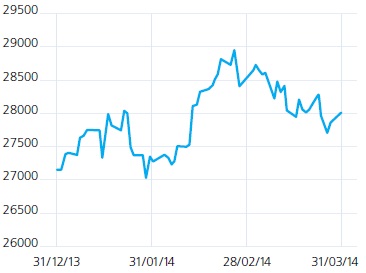Overview
The ASX 200 AREIT Accumulation index rose by 3.15% over the quarter ending 31 March 2014.
S&P ASX 200 AREIT Accumulation

The February reporting season contained few surprises with AREIT's generally reporting in-line with market expectations. Earnings per share (EPS) for the 6 months ending 31 December grew by 3.3% and Net Operating Income was up 2.3%. A modest increase in asset values in the sector led to a 2.5% increase in Net Tangible Asset growth.
Outlook
The outlook for key sectors is as follows:
Office
The improvement in global and local economic conditions would ordinarily flow through to increased office demand but CBD office vacancies have increased over the year (Sydney CBD 10%, Melbourne 11%, Brisbane 16% and Perth 11%). Brisbane has been impacted by the contraction in the government sector while the downturn in mining services has affected Perth. As a result, generous lease incentives have masked a fall in effective rents (by around 3% in Sydney and as much as 10% in Brisbane and Perth). Nevertheless, investor demand has actually driven an increase in prices for office properties, largely driven by the low interest rate environment. In conclusion, we expect economic conditions to improve office demand somewhat but large vacancy rates will continue to suppress rental growth and capital appreciation.
Retail
Vacancy rates have increased slightly but remain very low. Recent strength in retail sales is a positive development as has been the fall in the AUD, which reduces demand for online and imported goods. Overall, the 12 month outlook for the sector remains relatively positive.
Industrial
Primary demand for industrial property is driven by a need for warehouse facilities for the retail and logistics sector, as well as the manufacturing sector (heavy and light industrial usage). The improved domestic outlook should increase demand by retail and logistics, which should largely offset the ongoing decline in the manufacturing sector. We would expect rents to remain broadly flat until new supply becomes available.
Residential
AREITs exposed to residential property and construction should fare well over the next 18 months as low interest rates continue to fuel a housing recovery. With interest rates at record lows and household debt near record highs, we believe this recovery is unsustainable over the medium term.
Conclusion
In conclusion, the outlook for Australian equities remains more favourable than AREITs at this juncture. Nevertheless, the sector is reasonably valued and should remain supported in this low interest rate environment. We recommend investors retain a modest underweight exposure.
This publication is issued by Moore Stephens Australia Pty Limited ACN 062 181 846 (Moore Stephens Australia) exclusively for the general information of clients and staff of Moore Stephens Australia and the clients and staff of all affiliated independent accounting firms (and their related service entities) licensed to operate under the name Moore Stephens within Australia (Australian Member). The material contained in this publication is in the nature of general comment and information only and is not advice. The material should not be relied upon. Moore Stephens Australia, any Australian Member, any related entity of those persons, or any of their officers employees or representatives, will not be liable for any loss or damage arising out of or in connection with the material contained in this publication. Copyright © 2014 Moore Stephens Australia Pty Limited. All rights reserved.

